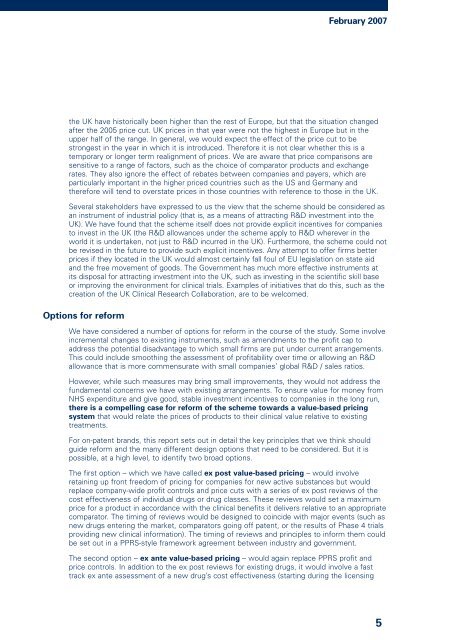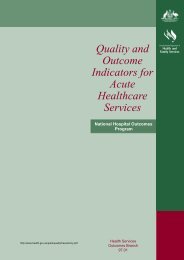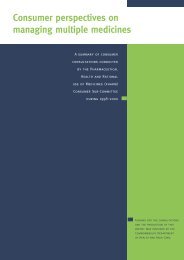The Pharmaceutical Price Regulation Scheme - Office of Fair Trading
The Pharmaceutical Price Regulation Scheme - Office of Fair Trading
The Pharmaceutical Price Regulation Scheme - Office of Fair Trading
Create successful ePaper yourself
Turn your PDF publications into a flip-book with our unique Google optimized e-Paper software.
February 2007<br />
the UK have historically been higher than the rest <strong>of</strong> Europe, but that the situation changed<br />
after the 2005 price cut. UK prices in that year were not the highest in Europe but in the<br />
upper half <strong>of</strong> the range. In general, we would expect the effect <strong>of</strong> the price cut to be<br />
strongest in the year in which it is introduced. <strong>The</strong>refore it is not clear whether this is a<br />
temporary or longer term realignment <strong>of</strong> prices. We are aware that price comparisons are<br />
sensitive to a range <strong>of</strong> factors, such as the choice <strong>of</strong> comparator products and exchange<br />
rates. <strong>The</strong>y also ignore the effect <strong>of</strong> rebates between companies and payers, which are<br />
particularly important in the higher priced countries such as the US and Germany and<br />
therefore will tend to overstate prices in those countries with reference to those in the UK.<br />
Several stakeholders have expressed to us the view that the scheme should be considered as<br />
an instrument <strong>of</strong> industrial policy (that is, as a means <strong>of</strong> attracting R&D investment into the<br />
UK). We have found that the scheme itself does not provide explicit incentives for companies<br />
to invest in the UK (the R&D allowances under the scheme apply to R&D wherever in the<br />
world it is undertaken, not just to R&D incurred in the UK). Furthermore, the scheme could not<br />
be revised in the future to provide such explicit incentives. Any attempt to <strong>of</strong>fer firms better<br />
prices if they located in the UK would almost certainly fall foul <strong>of</strong> EU legislation on state aid<br />
and the free movement <strong>of</strong> goods. <strong>The</strong> Government has much more effective instruments at<br />
its disposal for attracting investment into the UK, such as investing in the scientific skill base<br />
or improving the environment for clinical trials. Examples <strong>of</strong> initiatives that do this, such as the<br />
creation <strong>of</strong> the UK Clinical Research Collaboration, are to be welcomed.<br />
Options for reform<br />
We have considered a number <strong>of</strong> options for reform in the course <strong>of</strong> the study. Some involve<br />
incremental changes to existing instruments, such as amendments to the pr<strong>of</strong>it cap to<br />
address the potential disadvantage to which small firms are put under current arrangements.<br />
This could include smoothing the assessment <strong>of</strong> pr<strong>of</strong>itability over time or allowing an R&D<br />
allowance that is more commensurate with small companies’ global R&D / sales ratios.<br />
However, while such measures may bring small improvements, they would not address the<br />
fundamental concerns we have with existing arrangements. To ensure value for money from<br />
NHS expenditure and give good, stable investment incentives to companies in the long run,<br />
there is a compelling case for reform <strong>of</strong> the scheme towards a value-based pricing<br />
system that would relate the prices <strong>of</strong> products to their clinical value relative to existing<br />
treatments.<br />
For on-patent brands, this report sets out in detail the key principles that we think should<br />
guide reform and the many different design options that need to be considered. But it is<br />
possible, at a high level, to identify two broad options.<br />
<strong>The</strong> first option – which we have called ex post value-based pricing – would involve<br />
retaining up front freedom <strong>of</strong> pricing for companies for new active substances but would<br />
replace company-wide pr<strong>of</strong>it controls and price cuts with a series <strong>of</strong> ex post reviews <strong>of</strong> the<br />
cost effectiveness <strong>of</strong> individual drugs or drug classes. <strong>The</strong>se reviews would set a maximum<br />
price for a product in accordance with the clinical benefits it delivers relative to an appropriate<br />
comparator. <strong>The</strong> timing <strong>of</strong> reviews would be designed to coincide with major events (such as<br />
new drugs entering the market, comparators going <strong>of</strong>f patent, or the results <strong>of</strong> Phase 4 trials<br />
providing new clinical information). <strong>The</strong> timing <strong>of</strong> reviews and principles to inform them could<br />
be set out in a PPRS-style framework agreement between industry and government.<br />
<strong>The</strong> second option – ex ante value-based pricing – would again replace PPRS pr<strong>of</strong>it and<br />
price controls. In addition to the ex post reviews for existing drugs, it would involve a fast<br />
track ex ante assessment <strong>of</strong> a new drug’s cost effectiveness (starting during the licensing<br />
5




